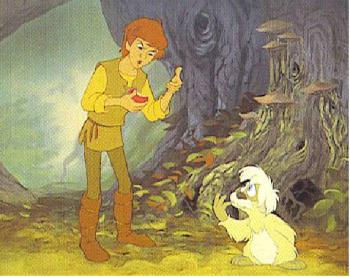Jim on Film
Page 5 of 6

(c) Disney
In its visuals, The Black Cauldron is a contradiction. The animation lines are very refined and crisp, and the backgrounds are detailed. The high price tag for the film is prevalent on the screen in every moment. Its many special effects, extensive use of multiplane effects, and even in its animated backgrounds, it is clear that all the stops were pulled out for this film, and it was lavished with great care and love.
While it has this flash and moxie, The Black Cauldron is by no means a beautiful film. The colors are pervasively dark and dreary, with even the scenes taking place outside during the day painted with muted browns and yellows. In fact, in many scenes there seems to be an attempt to make it as visually unappealing as possible. Because of this, its beauty is not found in its appearance but in its technical wizardry.
The animation and direction varies strongly throughout the film. For example, the Horned King’s entrance is expertly conceived, placing him in shadow and silhouette, building interest without giving anything specific. But for as much rich animation and direction as there is, there is also much that is average, such as much of the animation of Taran and Eilonwy. There are several scenes where they move but do not communicate much or do not do so with fluid realism.
Despite all this, The Black Cauldron is still a very enjoyable film. There are one or two lulls, but there is also enough action and adventure to keep it interesting and entertaining. Taran and Eilonwy are endearing enough, Gurgi and Fflewddur are lots of fun, and if the Horned King and Creeper seem too similar to Prince John and Sir Hiss, at least there is some humor in it. Looking back, there is probably much that the artists could have done better, but as it was finally released to theaters, it is by no means a disappointment.
It is also important to note that The Black Cauldron marked several firsts for the studio. One is that it is the first film to have an in-joke with the presence of Tinker Bell among the fair folk, a trademark of the new generation of filmmakers that continues on today.
There is also the presence of computer-generated imagery, another tradition that continues on today. Here, in its first incarnation, the images blends nicely with the hand-drawn art surrounding them.
There are many differences between The Black Cauldron and The Great Mouse Detective, though the most striking is that, despite being released a year apart from each other, The Great Mouse Detective looks like it was made yesterday while the print from The Black Cauldron looks ready for an extensive restoration.
If The Black Cauldron had scenes of great animation, all of The Great Mouse Detective displays a high level of animation skill. In a giant step away from The Black Cauldron, the colors are lively and the character designs are appealing. While it has visual appeal, it is also almost completely void of the visual thrills found in The Black Cauldron, with the climax in Big Ben being the only visual delight (other than great animation and beautiful backgrounds).
The film feels very fresh from beginning to end, and it is a move toward a more contemporary sense of humor. The scene of Basil figuring out how to get Dawson and himself out of the mousetrap, in its conception, animation, staging, and timing, is very funny and is a good example of this contemporary sensibility. In addition to this, the characters are colorful and memorable; even little Olivia is lots of fun.
What always gets the most attention is, of course, the exciting climax in Big Ben with its computer-generated imagery that allows the characters to move about the gears while the camera follows behind providing for an action-packed, exciting climax that, despite some criticism to the contrary, is a perfect blending of the two techniques.
